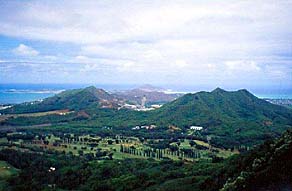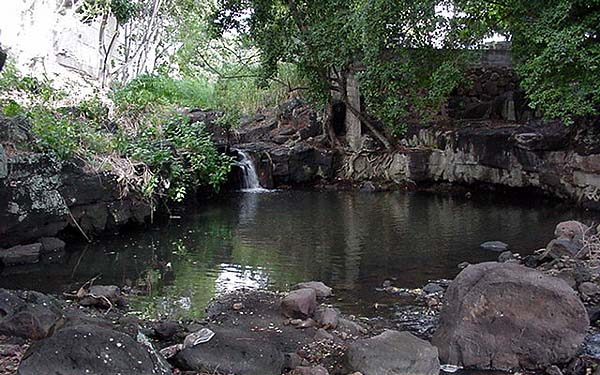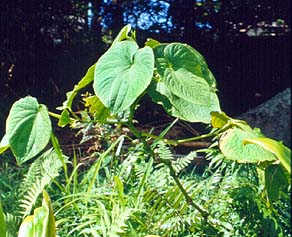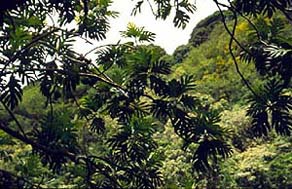 |
 |
 |
|||||||||||||||||||||
|
|
|
|
|
|
|
|
|
||||||||||||||||
|
|
|||||||||||||||||||||||
| |
|
|
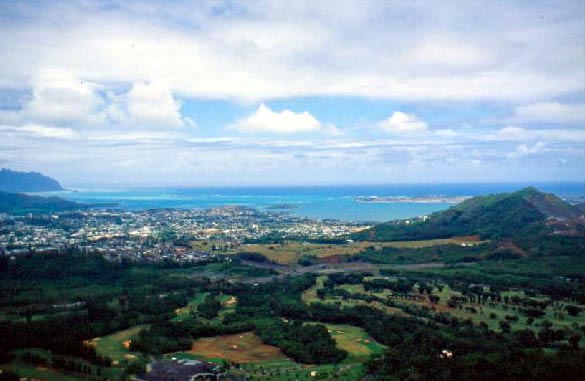
|
| As part of Honolulu ahupua‘a, Nu‘u anu is bounded by five neighboring ahupua‘a. The mountain ridge of the Ko‘olaus forms the moku ‘aina boundary between the Kona ("Leeward") district and the Ko‘olau-poko ("short windward") district. The structure and formation of the valley is such that it touches two valleys on the Ko‘olau-poko side of the mountains. These are Kailua and Kane‘ohe, both lying at the foot of the Pali Gap at the top of Nu‘uanu.
|
||
|
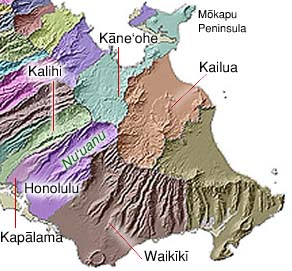
|
These two valleys are separated by the Mokapu peninsula, which extends out to sea directly from the Pali Gap of Nu‘uanu. Mokapu was said to have been the scene of royal pageantry in the 16th century, under the rule of King Peleiholani. Later, Kamehameha selected this site as a place for meeting with his ali‘i. Hence the name Mokapu is a shortened form of "moku-kapu," or "taboo district." Kane-‘ohe, "bamboo husband," is said to be so named because a women described her husband's cruelty as cutting like a bamboo knife. Kai-lua, "two seas," is probably named for different ocean currents.
|
|
At the same time, Honolulu ahupua‘a is bounded by the very large Waikiki ahupua‘a to the East (the "Diamond Head" direction) and by two different ahupua‘a to the west (the "ewa" direction). These are Kapalama and Kalihi. Ka-pa-lama means "the lama-wood enclosure." Hawaiian historian David Malo wrote that an enclosure made of the sacred wood of the lama tree surrounded a place where young ali‘i were kept just before pairing off. The first-born child of high chiefs was considered one of the highest ranking ali‘i under the traditional system. Selected young ali'i of both sexes were placed here, and after religious ceremonies had been performed and mating accomplished, they were permitted to leave.
|
|
|
|
|
|
| "Haumea takes human form and as Walinu‘u becomes the wife of Wakea and comes to live on the hill Kilohana in the uplands of Kalihi valley on O‘ahu. There they eat wild bananas, taro and yam, with goby fish (‘o‘opu) and shrimps from the stream. One day Haumea longs for seafood and goes across to He‘eia after crabs and seaweed. As she fills her container she has a premonition that all is not well and hurries home." Meanwhile, her husband goes over to the banana field of a neighboring chief, Kumuhonua, and rests there. "On account of the refreshing atmosphere in the shade of the bananas he fell asleep, and while so sleeping he was arrested by the watchman of the field and charged with stealing bananas.'"
|
||
|
||
|
|
Racing back over the Ko‘olau ridge, Haumea descends Nu‘uanu. By the bank of Waolani Stream, she encounters a farmer, Kali‘u. "He saw her, a beautiful woman adorned with the greenery of the upland and greeted her....She returned his greeting and asked what news there was in the lowland. 'Ah,' he replied, 'There is some news. A man is to be burned to death today, and there is a fire being lighted'." Learning that his farmer pities the fate of her husband, she asks him for some ‘awa to chew. Kali‘u says that he indeed has ‘awa, but that there is no water. "No, we have none and have to depend on the rains to fall and the water to flow down Waolani stream. It is well with us in the rainy season but when the warm summer days come, we are without." Haumea replies, "You chew the ‘awa and I will seek water."
|
| "She went out, glanced here and there and saw a large rock. She went up to it and then turned to call Kali‘u....He came...She said, 'I will throw this stone at the Waolani stream, and if the water splashes and the fine drops rise up in the air like the mists that nestle on the mountain tops, that is the water of Puehuehu.' 'Say, stranger, how can you throw that rock at that solid hillside to get water. Several times forty men cannot move it and you are all alone. How can you do it?' 'Watch me,' she said. "She uttered a prayer....and a fork of lightning struck the side of the rock....Kali‘u watched in amazement as she lifted and tossed it. A gust of wind went by that almost knocked him off his feet.... The rock struck and the earth trembled. He saw a spray of water rise up into the air from Waolani stream. "She sent him to fetch the water and he found a spring on this side of the river where the water fell into a deep pool below. That is the pool of Puehuehu ('the spray scattered') to this day."
|
Waolani Stream.
|
|
Haumea chases the chief's men down Kaho‘okane, the ancient trail that went down past Puehuehu to a place called Nini, just above Waikahalulu Falls. "She ran along, and when they were near to the breadfruit tree of Nini she met them. She saw her husband with his arms crossed and tied in back and with no malo (loincloth) on. Pity welled up in her, and her tears flowed. (Who among us who has a companion to embrace in the long nights of Ho‘oili (winter) could remain unmoved at seeing the shame and humiliation to which he was being subject? Aloha ‘ino!)." Haumea "slapped at her husband, and as he spun around, the breadfruit tree split open. The two went into the tree, and the crack closed up tight. They went out the other side and down to Ka‘oehuehu. Where Wai-ka-halulu and Pehuehu streams join, [she] threw off her pa'u of beach morning-glory vines. (It grows there to this day--a wondrous thing, for this is a plant seen only at the seashore.)"
|
|
|
|
| Thinking that the two had actually disappeared into the tree itself, the chief orders the tree to be cut down. But "whenever a chip flew and touched a man, he died; and whenever a drop of sap splashed on a man, he died. The blood of the tree was flowing." With the guidance of a kahuna, the men finally succeed in cutting the tree down. That tree became the goddess Kameha‘ikana, one of the goddesses of the O‘ahu chiefs and famous for her mana. She later became a goddess for Kamehameha during his reign.
|
||
|
||
| Nu‘uanu is full of many such storied places, to be discussed later. Now, we turn our attention to a selection of cultural sites which are part of what makes Nu‘uanu a Native Place.
|
||
|
||
| |
| |
|
|

|
| Nu‘uanu Home | Map Library | Site Map | Hawaiian Islands Home | Pacific Worlds Home |
|
|
|||
| Copyright 2003 Pacific Worlds & Associates • Usage Policy • Webmaster |
|||
